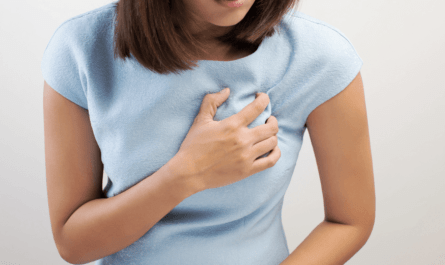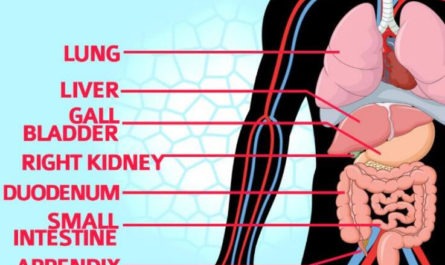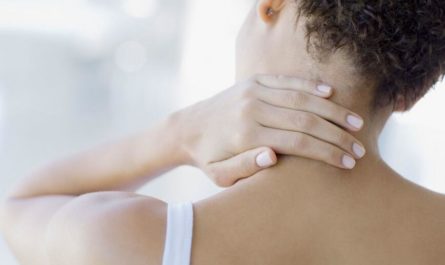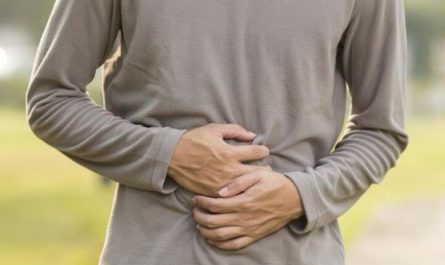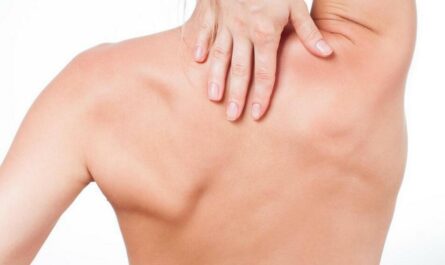Sneezing is a reflex action that helps clear irritants from the nasal passages. However, It can sometimes lead to discomfort or even sharp pain in the chest area. This article will explore the various causes of chest pain after sneezing and discuss the available treatment options. Understanding these factors can help you make informed decisions about your health and seek appropriate medical attention.
Symptoms of Chest Pain After Sneezing
Chest pain after sneezing can manifest in different ways, and the specific symptoms may vary depending on the underlying cause. Here are some common symptoms associated with chest pain after sneezing:
- Sharp or Stabbing Pain: The pain may be sudden and sharp, resembling a stabbing sensation in the chest area.
- Localized Discomfort: The pain is often localized to the chest region where the sneezing occurred.
- Muscle Tenderness: The muscles in the chest may feel tender to the touch, especially if the pain is caused by muscle strain.
- Radiating Pain: In some cases, the pain may radiate to other areas of the body, such as the arms, jaw, or back.
- Difficulty Breathing: Chest pain after sneezing may be accompanied by difficulty breathing or shortness of breath.
- Coughing: Sneezing-related chest pain can sometimes trigger coughing, exacerbating the discomfort.
- Increased Pain with Movement: Certain movements, such as deep breathing, coughing, or twisting motions, may intensify the pain.
- Palpitations: Individuals may experience an irregular or rapid heartbeat along with chest pain.
- Additional Symptoms: Depending on the underlying cause, other symptoms such as fever, cough, wheezing, or fatigue may be present.
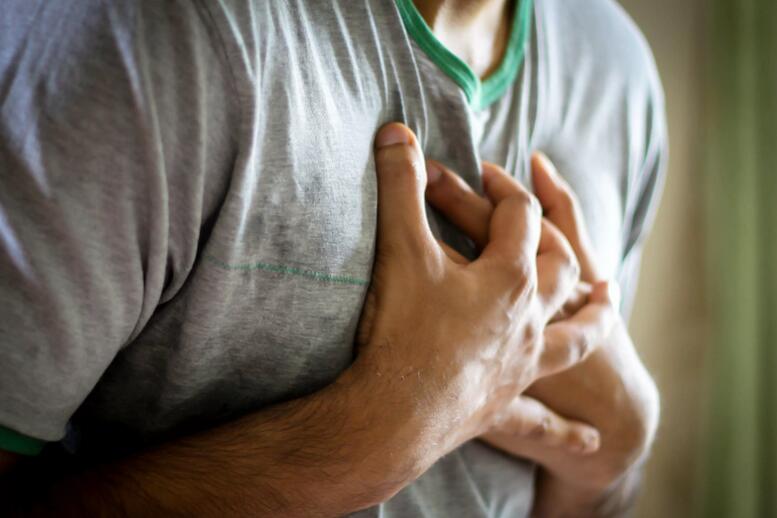
Common Causes of Pain in Chest after Sneezing
Let’s delve into more details about the eight common causes of chest pain after sneezing:
1. Muscle Strain
Sneezing forcefully can strain the muscles in your chest, leading to pain and discomfort. This is usually a temporary issue and not a cause for major concern. Symptoms may include localized pain in the chest area, tenderness, and difficulty with certain movements.
To alleviate muscle strain, you can rest, and take over-the-counter pain medications (like ibuprofen or acetaminophen). In addition, you can apply a warm or cold compress to the affected area. Gentle stretches and exercises can also help relieve pain and prevent future strain.
2. Rib Injuries or Fractures
If you already have a rib injury or fracture, sneezing can make the pain worse. You may feel localized pain in the injured area. Symptoms may include localized pain that worsens with deep breathing, coughing, or movement.
Treating rib injuries or fractures usually involves managing pain with over-the-counter or prescription pain medications and getting plenty of rest. In severe cases, you might need a rib brace or binding to help the healing process.
3. Upper Respiratory Infections
When you have a common cold or flu, your respiratory tract becomes inflamed and irritated. Sneezing during an infection can strain your chest muscles and airways, leading to chest pain. Symptoms may include cough, congestion, sore throat, fatigue, and body aches.
To treat upper respiratory infections, it’s important to rest, stay hydrated, and take over-the-counter medications to relieve symptoms. In some cases, your doctor may prescribe antiviral or antibiotic medications.
4. Pneumonia
Pneumonia is a more severe lung infection that can cause chest pain after sneezing. Along with chest pain, you may experience symptoms like cough, fever, and difficulty breathing.
Treating pneumonia usually involves taking antibiotics to target the specific bacteria causing the infection. Get plenty of rest, stay hydrated, and consider over-the-counter pain relievers to manage symptoms. In severe cases, hospitalization may be necessary for intravenous antibiotic treatment and supportive care.
5. Angina
Angina is chest pain or discomfort that occurs due to reduced blood flow to the heart muscles. Sneezing can temporarily increase the demand for oxygen by the heart, triggering chest pain in individuals with underlying heart conditions.
Symptoms may include chest discomfort or pressure, shortness of breath, and fatigue. Sometimes you may feel pain radiating to the left arm, jaw, or back.
To manage angina, making lifestyle changes like quitting smoking, adopting a heart-healthy diet, regular exercise, and stress management are crucial.
Medications such as nitroglycerin, beta-blockers, calcium channel blockers, or aspirin can be used to relieve symptoms and improve blood flow. In some cases, more invasive interventions like angioplasty or bypass surgery may be necessary.
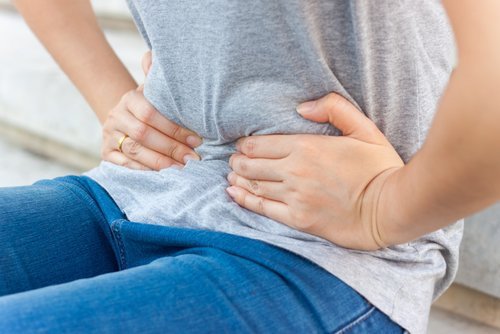
6. Gastroesophageal Reflux Disease (GERD)
GERD occurs when stomach acid flows back into the esophagus. This can cause chest pain that may worsen with sneezing. Symptoms may include a burning sensation in the chest (heartburn), acidic taste in the mouth, difficulty swallowing, and regurgitation of stomach acid
To manage GERD, you can make lifestyle modifications like avoiding trigger foods, eating smaller meals, and maintaining a healthy weight.
In some cases, Over-the-counter antacids or prescription medications like proton pump inhibitors (PPIs) or H2 blockers may be recommended to reduce stomach acid.
7. Anxiety and Panic Attacks
Sneezing can trigger chest pain in individuals with anxiety disorders or panic attacks due to heightened stress levels. This pain is usually related to the physical symptoms of anxiety and subsides once the episode passes.
Symptoms may include chest tightness, rapid heartbeat, shortness of breath, dizziness, and a sense of impending doom.
To manage anxiety and panic attacks, therapy, cognitive-behavioral techniques, relaxation exercises, and medications. Learning stress management techniques and practicing self-care can also help reduce the intensity of anxiety-related chest pain.
8. Other Cardiac Conditions
In rare cases, chest pain after sneezing may be a symptom of more serious cardiac conditions like a heart attack or unstable angina. Symptoms may include severe chest pain or pressure, shortness of breath, profuse sweating, nausea, and lightheadedness.
These conditions require immediate medical attention. Treatment for cardiac conditions depends on the specific diagnosis and severity. In some cases, surgical interventions like angioplasty or bypass surgery.

Natural Remedies for Chest Pain After Sneezing
Remember, while these natural remedies may provide temporary relief. It’s important to consult with a healthcare professional for an accurate diagnosis and proper treatment.
1. Applying Heat or Cold
Applying heat or cold to the affected area can help reduce inflammation and provide relief from chest pain. Heat therapy can help relax muscles and improve blood circulation. You can use a heating pad or a warm towel.
Cold therapy, using an ice pack or a cold compress, can numb the area and reduce swelling. Alternate between heat and cold therapy, applying each for about 15-20 minutes at a time, and repeat as needed.
2. Gentle Stretching and Exercise
Gentle stretching exercises can help relieve muscle tension and promote healing. Chest stretches, shoulder rolls and gentle backbends can help alleviate muscle strain in the chest area.
Consult with a healthcare professional, or physical therapist to learn the appropriate exercises that suit your condition. They can guide you on the frequency and intensity of the exercises to avoid further injury.
3. Strengthen Chest and Core Muscles
Engaging in regular exercises that target the chest and core muscles can help strengthen them and reduce the risk of strain during sneezing. Incorporate exercises like push-ups, chest presses, planks, and Pilates into your fitness routine. However, consult with a healthcare professional or certified trainer to ensure proper form and technique.
4. Herbal Remedies
Some herbs possess anti-inflammatory and analgesic properties that may help alleviate chest pain. Turmeric, with its active compound curcumin, has been traditionally used for its anti-inflammatory effects.
Ginger has also been recognized for its potential pain-relieving properties. Boswellia, derived from the resin of the Boswellia tree, may help reduce inflammation and relieve pain. These herbs can be consumed as dietary supplements, incorporated into meals, or consumed as herbal teas.
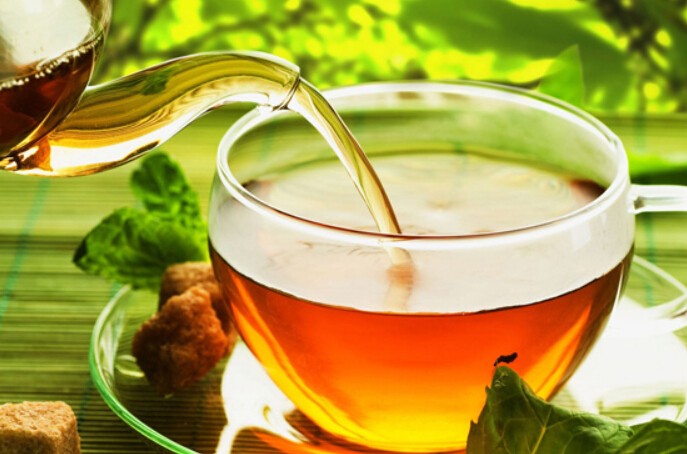
5. Deep Breathing and Relaxation Techniques
Deep breathing exercises and relaxation techniques can help reduce stress, promote relaxation, and alleviate chest pain. Diaphragmatic breathing, in which you focus on deep and slow breaths that engage the diaphragm.
This can help relax the chest muscles and improve oxygen flow. Find a quiet and comfortable space to practice these techniques regularly, aiming for at least a few minutes each day.
6. Maintaining Good Posture
Poor posture can contribute to muscle strain and exacerbate chest pain. Practicing good posture can help alleviate strain on the chest muscles. When sitting or standing, keep your back straight, shoulders relaxed, and head aligned with your spine.
Avoid slouching or hunching forward, as this can strain the chest muscles. Consider using ergonomic supports, such as a lumbar roll or cushion, to support your back and encourage proper posture.
7. Adequate Rest and Sleep
Rest and sleep are essential for your body to heal and recover. Ensure you have a comfortable sleeping environment, including a supportive mattress and pillows.
Establish a regular sleep routine, aiming for 7-9 hours of quality sleep each night. Avoid activities that may interfere with sleep, such as consuming caffeine or using electronic devices close to bedtime.
8. Avoiding Trigger Foods
If you suspect that acid reflux or gastroesophageal reflux disease (GERD) may be contributing to your chest pain, it may be helpful to avoid trigger foods that can worsen symptoms.
Common trigger foods include spicy and fatty foods, citrus fruits, caffeine, chocolate, onions, garlic, and carbonated beverages.
Keeping a food diary can help identify specific triggers that affect you personally. It’s also beneficial to eat smaller, more frequent meals, and avoid lying down immediately after eating.
9. Stress Management
Stress can contribute to muscle tension and exacerbate chest pain. Engaging in stress management techniques can help reduce stress levels and promote overall well-being.
Regular exercise, such as walking, jogging, yoga, or tai chi, can help release tension and promote relaxation. Mindfulness practices, such as meditation, deep breathing exercises, and progressive muscle relaxation, can help calm the mind and reduce stress.
Engaging in hobbies, spending time with loved ones, and seeking support from a therapist or support group can also aid in stress management.
10. Practice Proper Sneezing Etiquette
When you feel a sneeze coming on, practice proper sneezing etiquette to minimize strain on the chest muscles. Cover your mouth and nose with a tissue or your elbow to prevent the forceful release of air. Avoid forcefully suppressing the sneeze, as it can increase pressure on the chest.
11. Manage Underlying Health Conditions
If you have underlying health conditions like respiratory issues or GERD, try to manage these conditions effectively. Following your treatment plan and taking prescribed medications can help reduce the risk of chest pain after sneezing.
FAQs
1. Can sneezing cause a heart attack?
No, sneezing itself does not cause heart attacks. However, individuals with underlying heart conditions may experience chest pain or discomfort during or after sneezing due to reduced blood flow to the heart muscles. If you have concerns about your heart health, it is advisable to consult with a healthcare professional.
2. Are certain people more at risk for chest pain after sneezing?
Individuals with weakened chest muscles, pre-existing injuries, respiratory conditions, or heart-related issues may be more prone to experiencing chest pain after sneezing. It is important to understand your risk factors and seek appropriate medical advice if needed.
3. How can I differentiate between a muscle strain and something more serious?
Differentiating between a muscle strain and a more serious condition can be challenging. If the pain is severe, persistent, or accompanied by other concerning symptoms such as shortness of breath or dizziness, it is advisable to seek medical attention. A healthcare professional can evaluate your symptoms and provide an accurate diagnosis.
When to Worry About Chest Pain After Sneezing?
While chest pain after sneezing is often benign, there are instances when it may indicate a more serious condition. It is important to be aware of red flags and seek medical attention if any of the following symptoms are present:
- Severe and persistent pain
- Shortness of breath or difficulty breathing
- Rapid heartbeat or palpitations
- Pain radiating to the arms, jaw, or back
- Dizziness or fainting
- Coughing up blood
Seeking prompt medical attention can help identify the underlying cause and ensure appropriate treatment.


